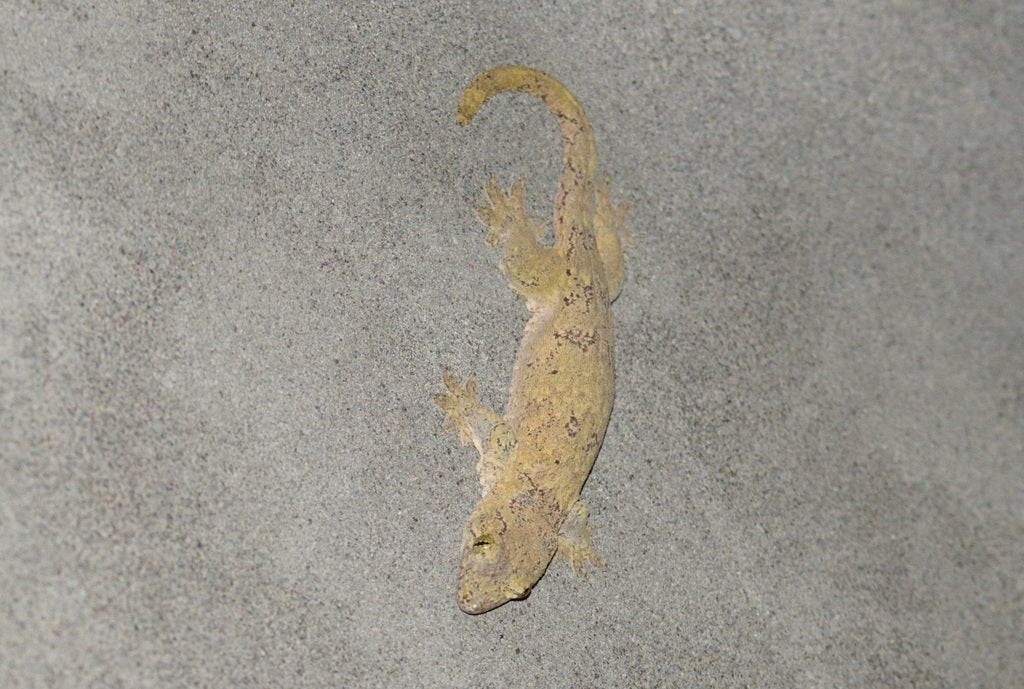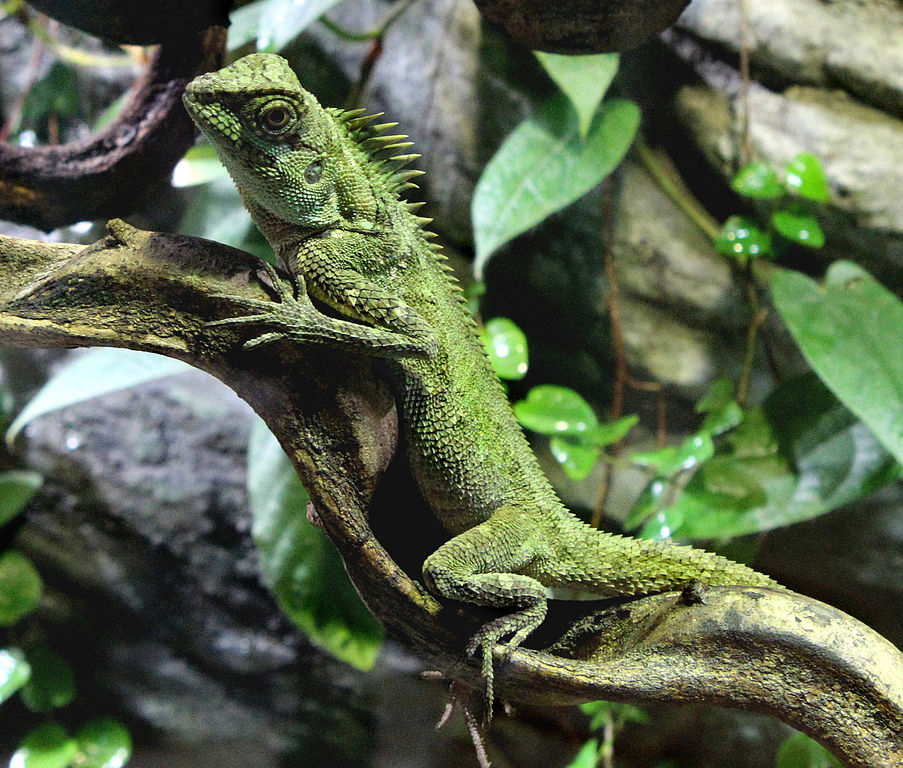Helmeted iguanas (Corytophanes cristatus) are medium-sized, diurnal, arboreal reptiles native to Central America, where they occupy rainforest areas. They are thought to spend most of their time in lower areas of the forest such as tree trunks and bushes.
Helmeted iguanas generally grow to around 14” long, with most of that being tail. They have a large head, large eyes, serrated throat flap, short laterally-compressed body, dorsal keel, long toes, and long slender tail. Their most distinct feature is the serrated or smooth casque on top of their head, which starts as a ridge above each eye and merges into a single prominent crest at the back of the head. This species is highly variable in coloring and pattern. They can have a base color of pale yellow, rusty orange/red, olive, green, or brown. They may be patternless, have a subtle leaflike pattern, or a striking pattern of irregular black stripes. The tail may or may not have dark banding.
Helmeted iguanas are highly sensitive to potential threats, so they’re a better display animal than a pet that can be handled regularly.
How much space do helmeted iguanas need?
Due to their extremely long tails, helmeted iguanas look smaller than they are, but a single individual should still be housed in no smaller than a 18”L x 18”W x 36”H enclosure. If at all possible, larger is recommended, particularly wider.
Cohabitation (keeping multiple helmeted iguanas in the same enclosure) is not recommended.
Do helmeted iguanas need UVB?
UVB is required for helmeted iguanas to stay healthy. Aside from helping provide a day/night cycle and providing an infinite supply of vitamin D, UVB is also good for the lizard’s overall health. Here are the best UVB bulbs for a helmeted iguana housed in a 36” tall enclosure:
- Arcadia ShadeDweller Pro UVB kit
- Zoo Med T8 Reptisun 10.0
If the UVB is mounted over mesh, place the basking branch so the lizard’s back will be 6-8” below the lamp. If the UVB is mounted inside the enclosure, place the basking branch so the lizard’s back will be 8-10” below the lamp.
The UVB bulb should be roughly half to two-thirds the length of the enclosure. It should also be housed in a reflective fixture by Arcadia or Vivarium Electronics, and placed on the basking side along with the heat lamp. Make sure that the fixture your UVB bulb is housed in does not have a clear plastic bulb cover.
Since helmeted iguanas are active during the day, it’s likely to be beneficial to provide an additional daylight-spectrum lamp to make sure the enclosure is brightly illuminated. They’re primarily shade-dwellers, so a single T5 HO fluorescent plant grow light will be plenty.
Lights should be on for 13 hours/day during summer and 11 hours/day during winter.
What basking temperatures do helmeted iguanas need?
Helmeted iguanas need a basking area temperature of 90-95°F and a cool side temperature between 75-80°F. Average temperature in the enclosure should stay between 80-85°F. Temperatures should be measured with digital probe thermometers, with probes placed on the basking spot and the floor on the cool side.
The basking surface itself should be a thick, sturdy wood branch placed near the top per the specifications listed previously.
Provide heat for your pet by imitating the sun with a cluster of halogen heat lamps placed on one side of the enclosure. You will need enough lamps to evenly heat an area at least the size of the lizard’s body. Do not use heat mats, red bulbs, or blue bulbs, as these are not as effective.
Nighttime temps should be no lower than 75°F. If needed, a lightless heat source such as a radiant heat panel can be used to maintain the minimum air temperature.
What humidity levels do helmeted iguanas need?
Helmeted iguanas are a tropical species that needs a humid environment to stay healthy. Humidity levels should be between 60-70% during the day and higher at night. Humidity should be measured with a digital probe hygrometer with the probe in the middle of the terrarium.
Misting 1-2x/day with a pressure sprayer and/or using a reptile humidifier connected to a humidistat at night is helpful for maintaining high humidity. Reptile humidifiers and foggers should only be used with distilled water and require weekly disinfecting to keep your reptile from getting sick.
What substrate is good for helmeted iguanas?
Although helmeted iguanas spend a lot of time either climbing among branches or swimming down below, using substrate in the enclosure will cover the floor and help provide a cushion in the unlikely event that the lizard falls from its perch. It also helps maintain humidity!
We recommend the following substrates for helmeted iguanas:
- Zoo Med Eco Earth
- Zoo Med ReptiSoil
- Exo Terra Plantation Soil
- Zilla Jungle Mix
For best results, layer your substrate with a generous amount of clean leaf litter on top!
Substrate should be at least 4” deep and completely replaced every 3-4 months. Remove poop and urates daily, along with any contaminated substrate.
What décor can you use in a helmeted iguana terrarium?
Helmeted iguanas need an enclosure where they have opportunities to hide, climb, and perform other instinctive behaviors. One of the best ways you can help your pet be happy in its enclosure is to fill it with things for the lizard to use and interact with. An empty enclosure is a stressful enclosure!
At bare minimum, you will need some vertically-oriented branches, foliage for cover, and a thick layer of substrate. Don’t be afraid to clutter it up! Looking at pictures of helmeted iguanas in the wild can be a great source of inspiration for figuring out how your pet’s terrarium should look.
All climbing branches should be securely anchored into the walls/floor of the enclosure to prevent collapse.
What do helmeted iguanas eat?
Helmeted iguanas are insectivorous, which means that they need a diet of primarily insects to get the nutrition that they need. Although they mostly eat insects, they are also known to eat smaller lizards on occasion. This species is unique in that they generally prefer to take on relatively large, slow-moving prey.
How often they need to eat varies depending on age. Juveniles should eat daily, and adults should be fed every other day. Offer as much food as the lizard will eat in a 5 minute period. Feeders should be roughly the same size as the lizard’s head.
Protein options for helmeted iguanas: discoids, dubias, earthworms, hornworms, silkworms, mealworms, superworms, feeder geckos
For a healthy, happy pet, offer as much dietary variety as you can!
Supplements
You will also need calcium and vitamin supplements to prevent your lizard from developing a deficiency. We recommend Repashy Calcium Plus LoD, lightly dusted on all insects.
Water
Of course, don’t forget a medium water bowl for your pet to drink from! Change the water daily and scrub the bowl with a reptile-safe disinfectant weekly, or whenever it becomes soiled.
Do helmeted iguanas like to be handled?
Truthfully, few reptiles actually “like” to be handled. Helmeted iguanas may have a natural “freeze” response when they feel threatened, and biting is only a last resort, but that doesn’t necessarily make them handleable. This species is better suited to life as a display animal than one that gets lots of human interaction.
The key to building a trusting relationship with your pet is to keep the relationship positive. Try offering food from feeding tweezers!
*This care sheet contains only very basic information. Although it’s a good introduction, please do further research with high-quality sources to obtain additional information on caring for this species.
"Corytophanes cristatus 174580443" by Ashwin Srinivasan is licensed under CC BY 4.0.




Leave a comment
This site is protected by hCaptcha and the hCaptcha Privacy Policy and Terms of Service apply.